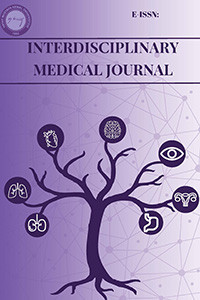İSOTRETİNOİN TEDAVİSİNİN NÖTROFİL/LENFOSİT ORANI VE DİĞER HEMOGRAM PARAMETRELERİNE ETKİSİNİN DEĞERLENDİRİLMESİ
Anahtar hemogram parametreleri, hemoglobin, monosit, nötrofil/lenfosit oranı kelimeler: Eozinofil, isotretinoin
Evaluation of the efficacy of isotretinoin treatment on neutrophil/lymphocyte ratio and the other hemogram parameters
Isotretinoin, hemogram parameters, hemoglobulin, neutrophil/lymphocyte ratio monocyte, eosinophil,
___
- Degitz K, Placzek M, Borelli C, Plewig G. Pathophysiology of acne. J Dtsch Dermatol
- Ges 2007;5:316-23.
- Ertam I, Alper S, Unal I. Is it necessary to have routine blood tests inpatients treated
- with isotretinoin? J Dermatolog Treat 2006;17:214–6.
- Michaelsson G, Vahlquist A, Mobacken H, Hersle K, Landegren J, Ronnerfalt L, et al.
- Changes in laboratory variables induced by isotretinoin treatment of acne. Acta Derm
- Venereol. 1986;66:144–8.
- Moeller KE, Touma SC. Prolonged thrombocytopenia associated with isotretinoin.
- Ann Pharmacother. 2003;37:1622–4.
- Karadag AS, Ertugrul DT, Takci Z. Isotretinoin modestly increases platelet count in
- acne patients.J Dermatolog Treat. 2013;24(2):139-40.
- Sen BB, Rifaioglu EN, Ekiz O, Inan MU, Sen T, Sen N. Neutrophil to lymphocyte
- ratio as a measure of systemic inflammation in psoriasis. Cutan Ocul Toxicol. 2013
- Oct 22. [Epub ahead of print]
- Jones H, Blanc D, Cunliffe WJ. 13-cis retinoic acid and acne. Lancet 1980; 2: 1048–9.
- Farrell LN, Strauss JS, Stranieri AM. The treatment of severe cystic acne with 13-cisretinoic
- acid. Evaluation of sebum production and the clinical response in a multipledose
- trial. J Am Acad Dermatol. 1980; 3: 602–11.
- Hesdorffer CS, Weltman MD, Raftopoulos H, Mendelow B, Bezwoda WR.
- Thrombocytopenia caused by isotretinoin.S Afr Med J. 1986;70(11):705-6.
- Coto-Segura P, Galache C, Santos-Juanes J, Mallo-García S, Curto-Iglesias JR.
- Transient thrombocytopenia probably induced by isotretinoin. Actas Dermosifiliogr.
- ;99(9):743-4.
- Michaëlsson G, Vahlquist A, Mobacken H, Hersle K, Landegren J, Rönnerfält L,
- Nordin K, Franzén K, Pettersson U. Changes in laboratory variables induced by
- isotretinoin treatment of acne. Acta Derm Venereol. 1986;66(2):144-8.
- Friedman SJ. Leukopenia and neutropeniaassociated with isotretinoin therapy. Arch
- Dermatol. 1987;123(3):293-5.
- Ozdemir MA, Kose M, Karakukcu M, Ferahbas A, Patiroglu T, Koklu E. Isotretinoininducedagranulocytosis.
- Pediatr Dermatol. 2007 Jul-Aug;24(4):425-6.
- Zane LT, Leyden WA, Marqueling AL, Manos MM. A population-based analysis of
- laboratory abnormalities during isotretinoin therapy for acne vulgaris. Arch
- Dermatol.2006 ;142(8):1016-22.
- Castrichini M, Lazzerini PE, Gamberucci A, Capecchi PL, Franceschini R, Natale M,
- Hammoud M, Moramarco A, Zimbone S, Gianchecchi E, Montilli C, Ricci G, Selvi E,
- Cantarini L, Galeazzi M, Laghi-Pasini F. The purinergic P2×7 receptor is expressed
- on monocytes in Behçet's disease and is modulated by TNF-α. Eur J Immunol. 2013
- Sep19.
- Yayın Aralığı: Yılda 3 Sayı
- Başlangıç: 2023
- Yayıncı: Hatay Mustafa Kemal Üniversitesi Tıp Fakültesi Dekanlığı
ALOPESİ AREATADA TOPİKAL PSORALEN VE ULTRAVİOLE A FOTOKEMOTERAPİSİNİN ETKİNLİĞİNİN DEĞERLENDİRİLMESİ
Bilge Şen, Özlem Ekiz, Emine Rifaioğlu, Tuğba Şen, Asena Doğramacı
Savaş Sarıkaya, Şafak Şahin, Lütfi Akyol, Turan Aktaş, Yavuz İntepe, Elif Börekçi, Yunus Yılmaz
ANESTEZİDE MERKEZİ VENÖZ KATETERİZASYONDA ULTRASONOGRAFİ KULLANALIM MI? (ÜÇ OLGU SUNUMU)
Kasım TUZCU, Murat KARCIOĞLU, İşıl DAVARCI, Onur KOYUNCU, Sedat HAKİMOĞLU, Orcan HABİB, Çağla AKKURT, Selim TURHANOĞLU
BÜYÜK SAFEN VEN YETMEZLİĞİNDE ENDOVENÖZ LAZER ABLASYON TEDAVİSİ TECRÜBELERİMİZ
Özgür Bulut, Ümit Halıcı, Atilla Kanca, Soner Sanioğlu
DÜŞME HİKAYESİ BULUNAN BİR ATEŞLİ SİLAH YARALANMA OLGUSU; OLAY YERİ İNCELEMENİN ÖNEMİ
Hüseyin KAFADAR, Safiye KAFADAR
Pınar Özuğuz, Seval Kaçar, Serap Polat, Sena Ulu, Şemsettin Karaca
BİRİNCİ TRİMESTERDE SAPTANAN İKİ AKRANİ OLGUSU
Nesrin ATCI, Ayşe GÜLER, Hakan YERAL, Atilla KARATEKE, Hanifi BAYAROĞLU
GENDEN TEDAVİYE YENİ YAKLAŞIMLAR: KODLAMAYAN NÜKLEİK ASİTLER
